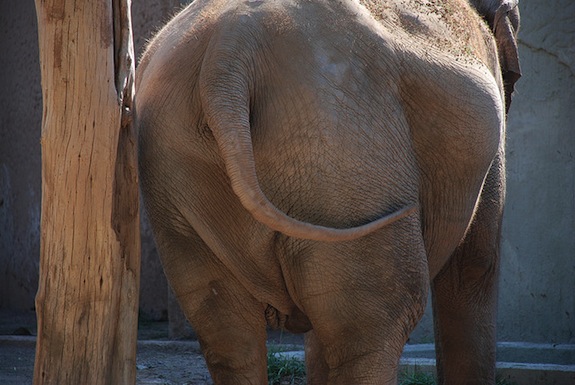To Measure Elephant Obesity, One Researcher Assesses Pachydermal Butts
It turns out that it’s really hard to figure out if an elephant is fat

Image: Matley0
Animals aren’t particularly cooperative models, and anyone who’s ever tried to photograph animals—domesticated or wild—probably has a lot of pictures of butts. But for one researcher, butt pictures are worth quite a lot. Kari Morfeld, a researcher at the Wildlife Conservation Research Center, uses pictures of elephant backsides to assess how healthy the elephants are.
Elephants in zoos are facing health problems that aren’t so different from humans’. Like us, elephants are becoming obese, a condition associated with cardiac disease, arthritis, infertility and all sorts of other problems. Forty-five percent of elephants in zoos right now are infertile, and the biggest killer of zoo elephants is heart disease. If we don’t do anything about it, the elephants we see in zoos will all be dead in 50 years.
Where do the butt pictures come in? It turns out that it’s really hard to figure out if an elephant is fat. “It is impractical to wrap tape measures around elephants’ torsos,” the Lincoln Journal Star reports. Plus, an elephant’s stomach volume changes drastically over the day, so one might look skinny in the morning, but quite fat at night.
So Morfeld developed a system that used butt shots from elephants to give them a relative health score. She looks at indications like the visibility of the rib cage and the depth of fat along the pelvic bone and back bone. Here’s the Journal Star:
“When we look at the bone structure, we see actual fat and not just volume,” she said.
In fat elephants, there is little distinction between the body and the backbone; the hip bones are not visible.
On her score sheet, skinny elephants get 1′s and fat elephants get 5′s. In the wild, most elephants come in around 2, but in zoos, 40 percent of elephants are 5′s.
Elephants gain weight for the same reasons humans do—diet and lack of exercise. In the wild, elephants eat a whole wide range of foods from grass to tree leaves to bamboo to bark. But in captivity they eat quite differently, with fruits and grains and high-quality hay full of calories. Morfeld suggests switching to less calorie-rich hay as a first step.
More from Smithsonian.com:
14 Fun Facts About Elephants
Saving Mali’s Migratory Elephants
/https://tf-cmsv2-smithsonianmag-media.s3.amazonaws.com/accounts/headshot/Rose-Eveleth-240.jpg)
/https://tf-cmsv2-smithsonianmag-media.s3.amazonaws.com/accounts/headshot/Rose-Eveleth-240.jpg)